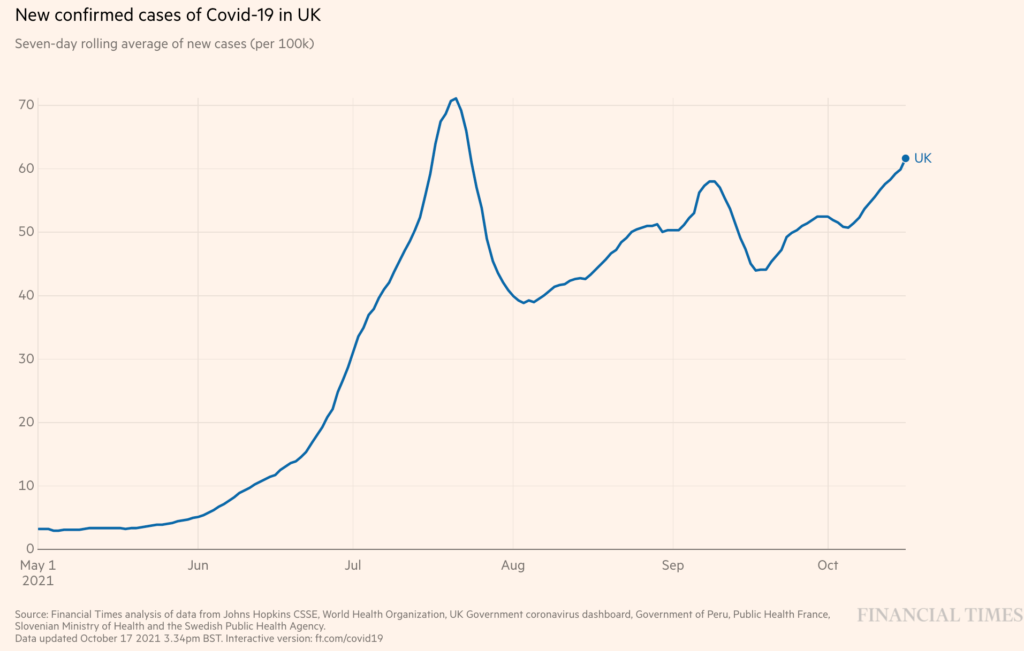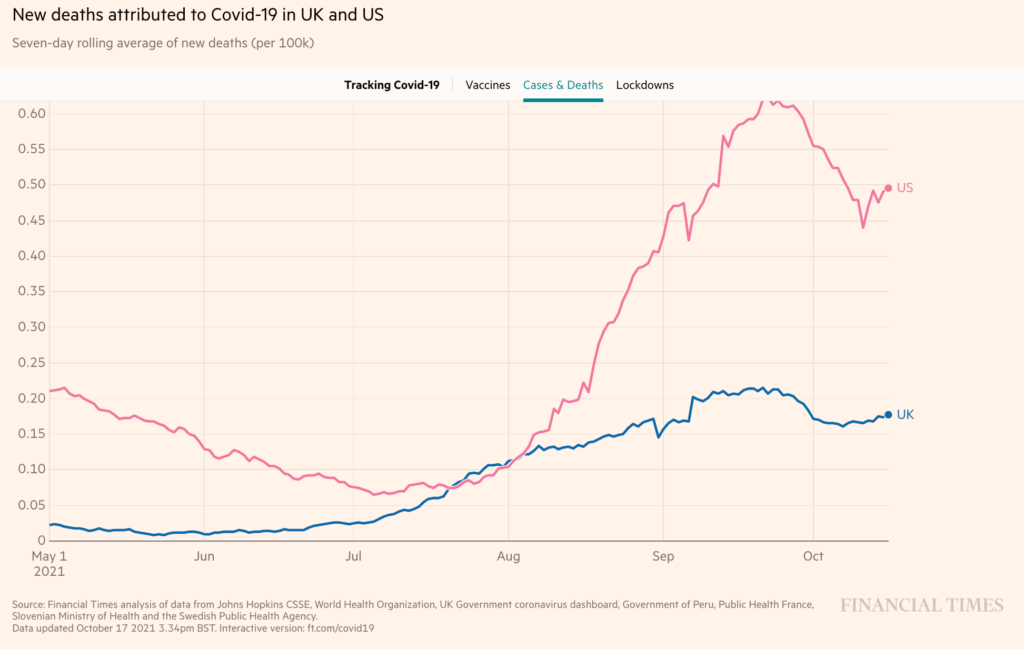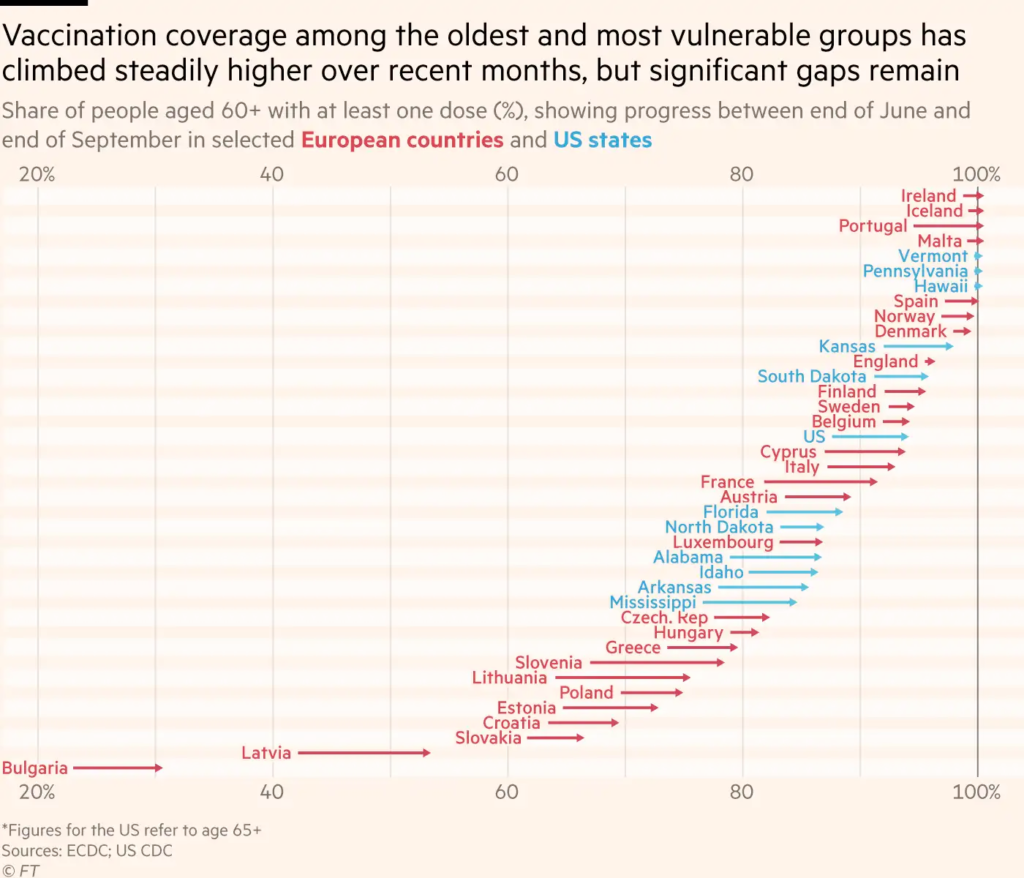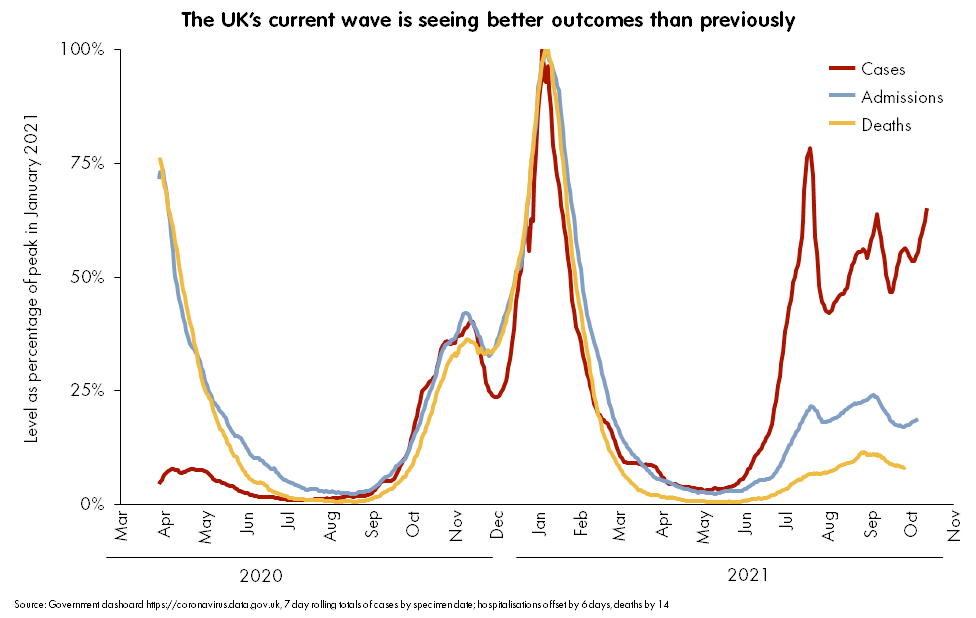A: We REALLY hope so. But we’ve learned that making predictions during this pandemic is… unwise.
After Delta spoiled optimistic summer and back to school plans in much of the U.S, the fall has brought an unexpected dive in confirmed case numbers. The 7-day rolling average of around 84K/day on October 16th is down more than 50% from the recent high of 175K on September 13th. Hospitalizations and deaths are also down considerably, suggesting the decline in transmission is real rather than an artefact of less testing.
❓Will this decline last?
I’m an optimist by nature, so I hate to deliver a pessimistic forecast. I *really* hope we’ve put the heights of daily cases (and especially deaths) in the rear-view mirror.
BUT….watching the US as an American living in the UK, I do worry that the UK may be a cautionary tale.

(I agree with Ted–tea is garbage water.)
The Delta wave took off much earlier here in the UK, starting in early June, peaking on July 20th at over 47,000 daily cases. Scientists made dire predictions of spikes to 100K per day as England continued with “Freedom Day” re-opening plans on July 19th. Instead, cases started falling sharply, down to around 25,000 daily cases in early August. Was this Delta surge running it’s two-month natural course?
Sadly not. After dropping steadily for a couple of weeks, cases in the UK ticked upward again and have continued to bounce around at a high plateau (see figure below and previous summary here. Current daily cases are at over 40,000 again, not far from the July peak.

Will this happen in the U.S.? Again predictions–especially about the future–are hard. Nonetheless, the case of the UK is illustrative. The stubborn persistence of Delta in the UK, which has HIGHER vaccination rates on average than the US (66% of the population fully vaxxed compared to 56% in the US), tells me that another dangerous surge in the U.S. is certainly *possible*.
The US is much more geographically heterogenous than the UK and has a wide range of vaccination rates in different parts of the country. Cases are falling in many places, but they are starting to rise in some areas of the country that are moving indoors (mainly Minnesota, Michigan, Colorado, New Hampshire, Vermont).
➕ column for continued case drops in the US:
➡️ Booster shots are ramping up.
➡️ Vaccination (hopefully) coming up soon for 5-11 year olds.
➡️ Employer vaccine mandates contributing to more first and second doses
➡️ Continued build up of immunity from infections (albeit at high cost)
➖ column for continued case drops in the US:
➡️ Many states with low vaccination rates
➡️ New 1st doses much more important than 3rd doses.
➡️ Low vaccine uptake among children (45.9% of US 12–15-year-olds fully vaccinated).
➡️ Increased mixing indoors and relatively few mitigations in many places.
It could be that the UK is unusual and this pattern won’t be repeated in the U.S. Cases in the UK are currently much higher than in their European neighbors. Compared to the rest of Western Europe, the UK is behind in vaccination rates (especially among teens) and has dropped mitigation such as masks, vaccine passports, and limits to large gatherings.
The UK also relied heavily on the Oxford/Astrazeneca vaccine, which has shown less protection against infection compared to the Moderna and Pfizer vaccines. Compared to the US however, the longer interval between doses used by the UK (up to 12 weeks) was likely beneficial to the strength and durability of immune response.
The UK also has a new variant (sublineage of Delta, called AY.4), that has increased in prevalence recently and is something to keep an eye on in case it is more transmissible or more likely to evade existing immunity.
(For a review of the current UK vs. Europe situation see here.)
⚠️ There is another metric by which the US is *still* doing worse than the UK.
Deaths per capita in the US have been much higher in the US compared to the UK (see figure).

This difference is likely due to the lower vaccine coverage in the US at older ages compared to the UK (81.4% of 75+ fully vaxxed in the US compared to over 95% in the UK). While this may not sound like a big difference, remember this group is by far the most vulnerable to COVID-19 deaths.

Having almost 20% of this group susceptible compared to 5% means a lot more deaths. (More on this)
💥 Finally, it’s also important to note that despite the continued high case rates, hospitalizations and deaths in the UK are dramatically lower than previous waves thanks to the vaccines (see figure). Indeed it’s frightening to think what an unvaccinated Delta wave would have looked like and we should not forget to marvel in this human achievement.

💥 In the U.S., cases, hospitalizations and deaths are much higher in states with low vaccination rates (See figure and thread from Benjy Renton.)

🎱 If we’ve learned anything during this pandemic, it’s that we should remain humble in guessing what is coming next. As epidemiologist Dr. Mike Osterholm likes to say, if anyone confidently states something about the future path of this pandemic, they also likely have a bridge to sell you.
In the U.S. we need to work hard to close that gap in coverage at older ages and reduce the high death rate. Meanwhile in the UK’s roll-out for teens has been painfully slow, with dire consequences for infections in that age group that are now trickling up to older age groups and sustaining high transmission.
⚡ What remains clear is that vaccination is our way out of this pandemic. Let’s get it done.
Love,
Nerdy Girl Jenn
Nerdy Girl Jenn on why U.S cases were falling in February, when many of the same explanations came up: “Why Are COVID-19 Cases Really Falling?”
If you’re not listening to Dr. Mike Osterholm’s weekly COVID-19 podcasts from Center for Infectious Disease Research and Policy (CIDRAP), it’s not too late to start!


